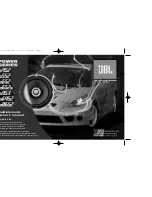
1
KEF LOUDSPEAKERS
What to look for when choosing your speakers
Of all the elements in your audio system, changing your speakers
can make the biggest difference in sound quality. As a rule of
thumb, the speakers in a basic two-channel hi-fi system often
account for about a third of the total system cost.
Speaker quality has a lot to do with size and the number of drive
units; but ultimately what matters is how well they reproduce
your kind of music or film soundtrack in your room at the volume
you most enjoy. Although technical specifications are helpful,
you can only find which model best suits your personal
preferences by hearing them in action. These are some of the
things you should be looking for...
Drive units
Hi-fi drivers are dedicated to different parts of the frequency spectrum.
Bass units reproduce sound between 20 to 500Hz, midrange drivers
(carrying most of the identifying tones of music or speech)
usually from 200Hz to 4kHz, and HF drivers (tweeters),
from 2kHz to above 20kHz. Long-throw drivers allow
a large amount of cone movement, and therefore
generate higher sound pressure levels. A strong
chassis such as cast aluminium provides a rigid
platform for the moving coil/cone assembly and avoids
the energy being drained from the cone into the cabinet
itself. Some form of mechanical decoupling between the chassis
and the cabinet can greatly reduce the transmission of this vibrational energy to
the cabinet walls.
Cone materials vary.Tweeters are usually made from metallic or fabric materials
- the former tend to be very revealing and detailed; the latter, a more
reserved sound.
Components
Crossovers act as the brains of a speaker,
allocating the various frequency ranges to the
appropriate drivers, with filters to stabilise
impedance loads and shape frequency response.
The quality of the components (such as polypropylene capacitors
and air-cored inductors) directly affects acoustic fidelity.
Setting up
High performance speakers usually have dual sets of connectors
(binding posts) and crossovers with separate sections for low and
high frequencies. This is to accommodate bi-wiring (using two
sets of cables to improve resolution) and bi-amping (in which
each set of connectors is wired to a separate amplifier for
optimum response across the frequency range). KEF’s new
Reference Series even features 3 pairs of connectors for
tri-wiring or tri-amping. Most speakers sound better after a few
hours use.All you have to do then is sit back and enjoy.
Imaging
Stereo imaging is the illusion of a realistic 3D presence that seems not to come
from the speakers themselves, but a virtual sound stage in which different
instruments or sound effects are localised. With conventional speakers
(as opposed to KEF Uni-Q), this illusion only occurs in a relatively small area -
the ‘sweet spot’.
To test speaker dispersion characteristics, move around the listening area.
Does the sound fade as you move away from the main axis of the speaker?
Do central images stay centrally located at some frequencies but not others?
Measuring performance
The smoother a speaker’s frequency response, the more faithful its reproduction
of the audio signal.Transient response is also important, reflecting the speaker’s
ability to respond quickly to any sudden change in the signal without blurring
(smearing) the sound. How loudly a speaker plays depends on its sensitivity,
maximum output capability and power handling. Low sensitivity speakers require
larger amounts of amplifier power to reach a given loudness level.
High sensitivity speakers require relatively less and
can be used to compensate for low amplifier power.
When compensating for low sensitivity speakers
remember that a 10dB increase in sound pressure
level, which sounds twice as loud, requires 10 times
more power.
Always look for a wide dynamic range in a speaker -
the range of sound intensity that can be reproduced
without distortion. It’s expressed as a ratio in
decibels. In speech, this is rarely more than 40dB;
in orchestral works, it can be as much as 75dB.
Judge whether loud passages sound appropriately
louder than quiet ones. Can you hear subtle changes
when something else is playing loud? Does music
come to life at high volume, or blur?
Ask yourself also whether the sound picture is complete at the frequency
extremes. Or has bass, for example, been sacrificed to midrange clarity?
Accuracy is a matter of how closely the speaker reproduces live sounds.
How much detail can you hear? Do individual images sound separate from each
other, or are they like highlights in an acoustic soup?
Neutral balance gives the human voice a natural timbre, without distortion at
frequency extremes. Listen for colouration - do voices sound strange? Is there
too much sibilance? Can you differentiate the sound of similar but different
instruments? Or does a violin sound like a viola, a Stratocaster like a Les Paul?
SPL(dB)
FREQUENCY(Hz)
110
100
90
80
70
60
20
200
2k
20k
Ci Reference 2000
FREQUENCY (Hz)
20
200
2k
Ci Ref 2000
31.6
10
3.16
20k
Ω
Содержание PSW1000.2
Страница 1: ...Uni Q Loudspeakers The Range...






























